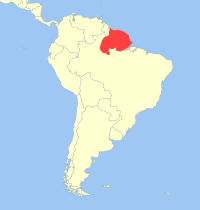- Red-handed tamarin
-
Red-handed tamarin[1] 
Conservation status Scientific classification Kingdom: Animalia Phylum: Chordata Class: Mammalia Order: Primates Family: Callitrichidae Genus: Saguinus Species: S. midas Binomial name Saguinus midas
(Linnaeus, 1758)
Geographic range in South America The red-handed tamarin (Saguinus midas), also known as the golden-handed tamarin or Midas tamarin, is a New World monkey named for the contrasting reddish-orange hair on their feet and hands. It is native to wooded areas north of the Amazon River in Brazil, Guyana, French Guiana, Suriname, and possibly Venezuela.[2] The population south of the Amazon River lacks the contrasting feet and hands, and is now commonly treated as a separate species, the Black Tamarin.
They live in cooperative groups of 4 to 15 members with little competition among a group even between breeding males. Only one female among a group will breed during breeding season with the other females suppressing the instinct. The gestation period is 140–170 days and mothers typically give birth to two offspring
Young tamarins are cared for primarily by the father and turned over to the mother only to nurse, however the entire group helps with the care of the young.
Defense is a priority in a group, and when one tamarin is threatened the others will rush to its defense. The red-handed tamarin is territorial and can be aggressive, with sharp canines and claws instead of fingernails on all fingers and all but the large toe.
The red-handed tamarin is an exceptional climber and spends most of its time among the vines and branches of the trees. They are quick and agile and are superb jumpers known to jump distances of over 60 feet (18 m) from a tree to the ground with no sign of injury.
The tamarin's diet consists of fruit, flowers, insects, frogs, spiders, lizards, and nectar.
The red-handed tamarin's body measures 20.5–28 centimetres (8.1–11 in); including the tail they measure 31–44 centimetres (12–17 in). They weigh 400–550 grams (0.88–1.2 lb). Their life expectancy is approximately 10 years in the wild and 16 years in captivity.
Their natural predators are small cats, birds of prey, and snakes.
References
- ^ Groves, C. (2005). Wilson, D. E., & Reeder, D. M, eds. ed. Mammal Species of the World (3rd ed.). Baltimore: Johns Hopkins University Press. pp. 135. OCLC 62265494. ISBN 0-801-88221-4. http://www.bucknell.edu/msw3/browse.asp?id=12100243.
- ^ a b Mittermeier, R. A., Rylands, A. B. & Boubli, J.-P. (2008). Saguinus midas. In: IUCN 2008. IUCN Red List of Threatened Species. Downloaded on 2 January 2009.
- Rylands AB and Mittermeier RA (2009). "The Diversity of the New World Primates (Platyrrhini)". In Garber PA, Estrada A, Bicca-Marques JC, Heymann EW, Strier KB. South American Primates: Comparative Perspectives in the Study of Bahavior, Ecology, and Conservation. Springer. pp. 23–54. ISBN 978-0-387-78704-6.
Categories:- IUCN Red List least concern species
- Mammals of South America
- Fauna of the Guianas
- Mammals of Brazil
- Fauna of Venezuela
- Fauna of French Guiana
- Mammals of Guyana
- Fauna of Suriname
- Callitrichidae
- Animals described in 1758
Wikimedia Foundation. 2010.

